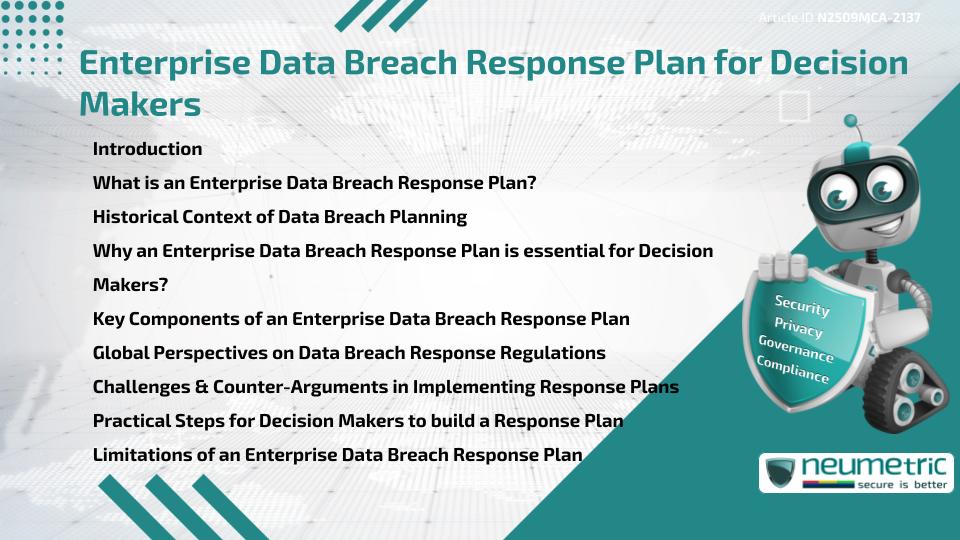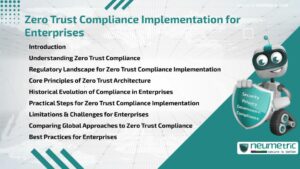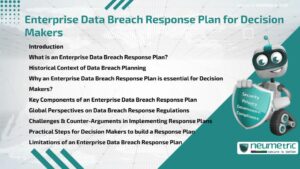Table of Contents
ToggleIntroduction
An Enterprise Data Breach Response Plan is a structured Framework that helps Organisations detect, manage & recover from Cyber Incidents. For Decision makers, such a Plan ensures Business Continuity, Legal Compliance & protection of Brand reputation. Without a Response Plan, Companies Risk severe Financial losses, Regulatory fines & long-term damage to Stakeholder Trust. This article explores the history, importance, components, global perspectives, challenges & practical steps involved in developing an effective Enterprise Data Breach Response Plan.
What is an Enterprise Data Breach Response Plan?
An Enterprise Data Breach Response Plan is a documented set of Procedures for Identifying, Containing & addressing Data Breaches. It outlines who should act, how to communicate with Stakeholders & what steps to take to prevent further damage. Just as Fire drills prepare Organisations for Emergencies, a Response Plan equips Companies to handle Cyber Incidents swiftly & effectively.
Historical Context of Data Breach Planning
In the early days of computing, Responses to Cyber Incidents were ad hoc, often relying on Technical Staff improvising under pressure. As Cyberattacks became more frequent & sophisticated, Regulators & Industry Bodies demanded structured approaches. High-profile Breaches in Finance, Healthcare & Retail Sectors highlighted the need for formal Enterprise Data Breach Response Plans. Today, many Regulations, including the General Data Protection Regulation [GDPR] and State Privacy Laws, require Companies to maintain Documented Plans.
Why an Enterprise Data Breach Response Plan is essential for Decision Makers?
For Decision makers, an Enterprise Data Breach Response Plan provides Clarity & Control during crises. Benefits include:
- Faster Identification & Containment of Breaches.
- Reduced Financial & Reputational damage.
- Legal Compliance with Reporting obligations.
- Clear Communication with Customers, Regulators & Partners.
- Enhanced Trust through Transparency & Accountability.
In many ways, having a Response Plan is like having insurance-it cannot prevent every incident, but it reduces the impact when one occurs.
Key Components of an Enterprise Data Breach Response Plan
An effective Enterprise Data Breach Response Plan includes:
- Preparation: Assigning roles, responsibilities & training.
- Detection & Analysis: Monitoring Systems to spot suspicious activity.
- Containment: Isolating affected Systems to prevent spread.
- Eradication & Recovery: Removing Threats & Restoring Operations.
- Communication: Informing Stakeholders, Regulators & Customers.
- Post-incident review: Learning from Breaches to improve future resilience.
These components ensure the Plan is not just reactive but also continuously improving.
Global Perspectives on Data Breach Response Regulations
Different regions enforce varying requirements. The EU’s GDPR mandates that Organisations notify Regulators within seventy-two (72) hours of discovering a Breach. The United States has State-level Laws with differing timelines & requirements. Countries in Asia, such as Singapore, also enforce strict Reporting Rules. While frameworks differ, the shared aim is to enhance Transparency & Accountability in handling Breaches.
Challenges & Counter-Arguments in Implementing Response Plans
Some businesses argue that developing an Enterprise Data Breach Response Plan is Costly & Resource-intensive, especially for Smaller Organisations. Others worry that rigid plans may not adapt well to evolving Threats. Additionally, balancing Transparency with Reputational concerns during Breach Disclosures can be challenging. Despite these counter-arguments, the Risks of not having a Plan far outweigh the challenges of implementation.
Practical Steps for Decision Makers to build a Response Plan
Decision makers can strengthen their Enterprise Data Breach Response Plan by:
- Conducting regular Risk Assessments.
- Creating an Incident Response Team with clear roles.
- Establishing Communication Templates for internal & external use.
- Running Simulation Exercises to test preparedness.
- Reviewing Legal requirements in jurisdictions of Operation.
- Updating the Plan after every significant Incident.
These steps turn the Plan from a static document into a living Framework.
Limitations of an Enterprise Data Breach Response Plan
Even the best Enterprise Data Breach Response Plan has limitations. Plans may not anticipate every type of Attack, particularly novel or highly sophisticated Threats. Resource constraints can limit execution. Additionally, Response Plans rely heavily on Human action, which introduces variability. For these reasons, Organisations must complement their Plans with Continuous Training & updated Security Measures.
Takeaways
- An Enterprise Data Breach Response Plan ensures structured handling of Cyber Incidents.
- Decision makers gain Clarity, Compliance & Protection of Reputation.
- Key components include Preparation, Detection, Containment, Communication & Review.
- Global Regulations vary but demand timely Reporting & Accountability.
- Challenges include Costs, Adaptability & Reputational Risks of disclosure.
- Continuous updates & Training are essential to maintain effectiveness.
FAQ
What is an Enterprise Data Breach Response Plan?
It is a documented process for Detecting, Containing & managing Cyber Incidents to reduce impact & ensure Compliance.
Why do Decision makers need such a Plan?
It provides Control, ensures timely Responses, reduces Risks & meets Regulatory requirements.
What Regulations require Breach Response Plans?
Frameworks like GDPR in the EU & various US State Laws mandate Documented Plans & timely Reporting.
What are the main steps in a Response Plan?
Preparation, Detection, Containment, Recovery, Communication & Post-incident review.
How quickly must Companies report Breaches?
Under GDPR, within seventy-two (72) hours. Other jurisdictions may have different timelines.
Can Small Businesses implement these Plans?
Yes, though scaled to size. Many Regulatory Agencies provide guidelines tailored for Smaller Firms.
Are Response Plans enough to stop Cyberattacks?
No, they cannot prevent Breaches but help reduce impact & improve resilience.
Need help for Security, Privacy, Governance & VAPT?
Neumetric provides organisations the necessary help to achieve their Cybersecurity, Compliance, Governance, Privacy, Certifications & Pentesting needs.
Organisations & Businesses, specifically those which provide SaaS & AI Solutions in the Fintech, BFSI & other regulated sectors, usually need a Cybersecurity Partner for meeting & maintaining the ongoing Security & Privacy needs & requirements of their Enterprise Clients & Privacy conscious Customers.
SOC 2, ISO 27001, ISO 42001, NIST, HIPAA, HECVAT, EU GDPR are some of the Frameworks that are served by Fusion – a SaaS, multimodular, multitenant, centralised, automated, Cybersecurity & Compliance Management system.
Neumetric also provides Expert Services for technical security which covers VAPT for Web Applications, APIs, iOS & Android Mobile Apps, Security Testing for AWS & other Cloud Environments & Cloud Infrastructure & other similar scopes.
Reach out to us by Email or filling out the Contact Form…





